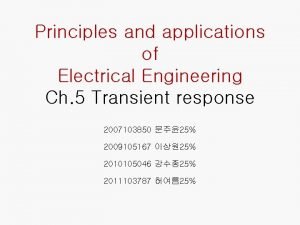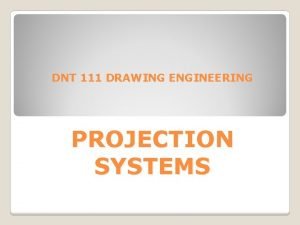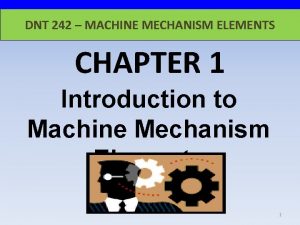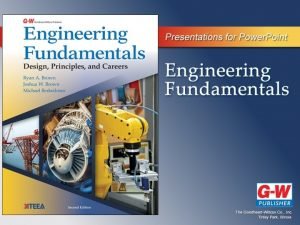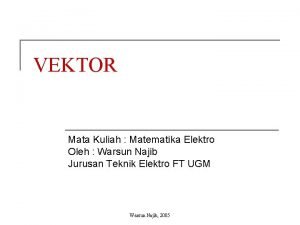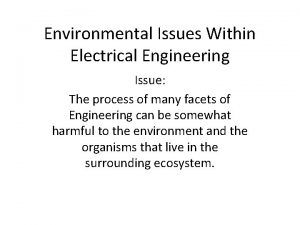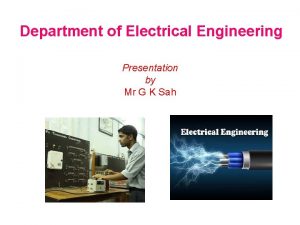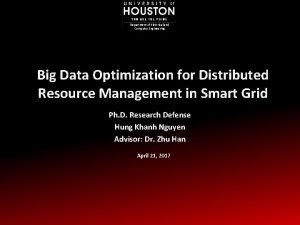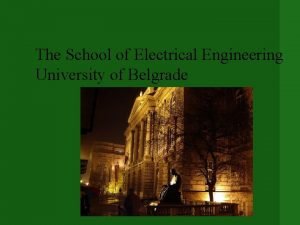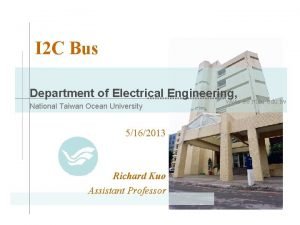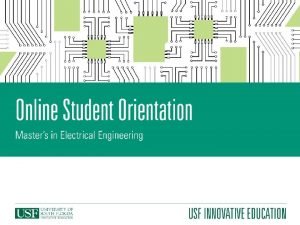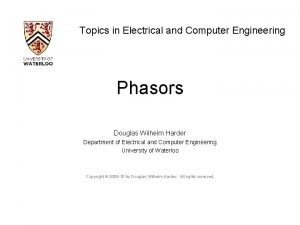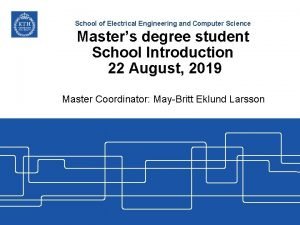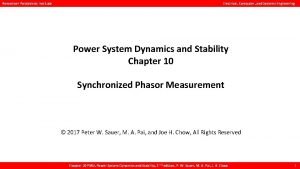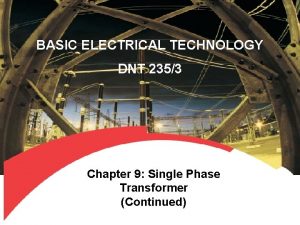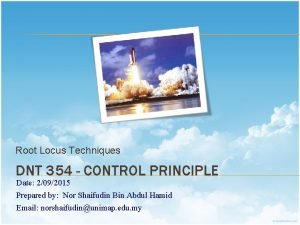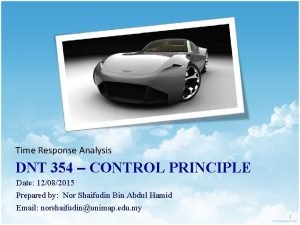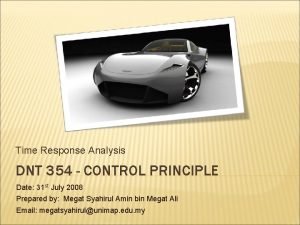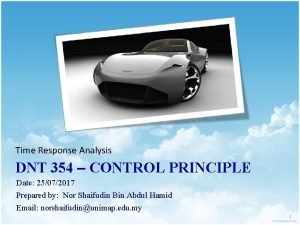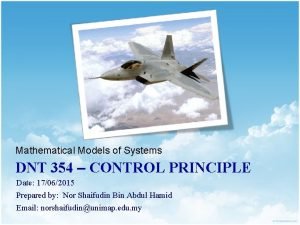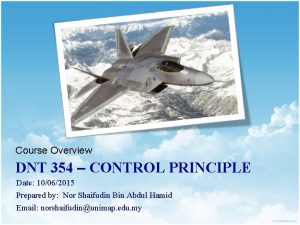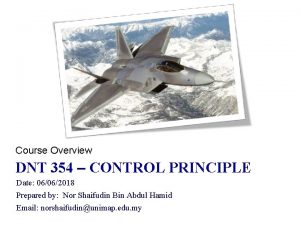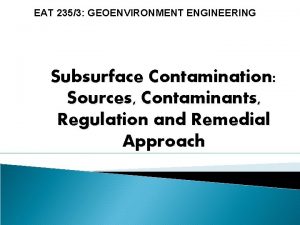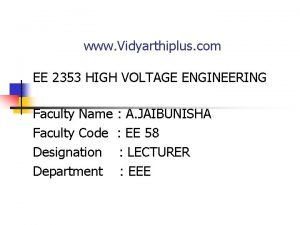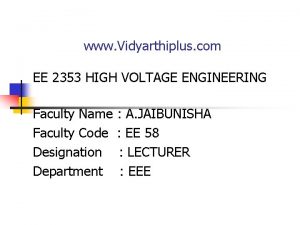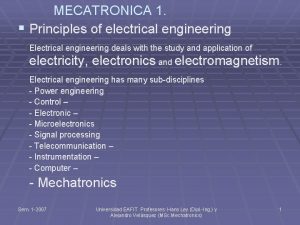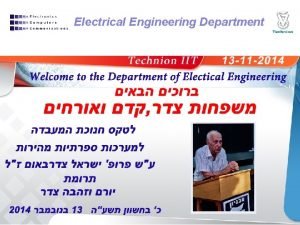Electrical Engineering Principle DNT 2353 CHAPTER 10 THREE






























- Slides: 30

Electrical Engineering Principle DNT 235/3 CHAPTER 10 THREE PHASE TRANSFORMER baizura@unimap. edu. my

Three Phase Transformer 2

The knowledge that students can obtain from this chapter are: • Basic principle and structure of a three phase transformer. • Description of winding connections, delta and star configurations and autotransformer. 3

Construction • A three-phase transformer is constructed by winding three single-phase transformers on a single core. • Three-phase transformers are connected in either wye or delta configurations. 4

Three-phase transformer construction 5

The basic principle of a 3 phase transformer. • • The figure shows which primary windings have been shown inter connected in star output across 3 phase supply. The three cores are 120 o apart and their empty legs are shown in contact with each other. The centre leg, formed by these three, carries flux produced by the three-phase currents IR, IY and IB. As any instant IR+ IY + IB = 0, hence the sum of three flux is also zero. Therefore, it will make no difference if the common legs will act as the return for the third just as in a three phase of system any two conductors act as the return fore the current in the third conductor. 6

Basic Structure • Three similar limbs are connected by the top and bottom yokes, and each limb having primary and secondary windings are arranged concentrically. • The primary is shown by star-connected and the secondary by delta connected. 7

Based on STRUCTURE OF COILS 1. air core -- inside area of coil is empty -- inefficient induction 2. open core --- ferromagnetic material inside coils B = induction 8

(cont. ) 3. closed core -- ferromagnetic ends connected -- B =induction 4. shell -- lazy square eight -- overlap of coils on same ferromagnetic core 9

Transformer Type

Three phase transformer connections. • Labeling of transformer terminal – Terminal on the HV side of each phase will be labeled as capital letters A, B, C. – Terminal on the LV side will be labeled as small letters a, b, c. – Terminal polarities are indicated by suffixes 1 and 2 with 1’s indicating similar polarity ends and so do 2’s. – Assuming the transformer to be ideal, VA 2 A 1 (voltage of terminal A 2 with respect to A 1) is in phase with Va 2 a 1 and IA is in phase with Ia. 11

• There are only 4 possible transformer combinations: • Delta to Delta - use: industrial applications • Delta to Wye - use : most common; commercial and industrial • Wye to Delta - use : high voltage transmissions • Wye to Wye - use : rare, don't use causes harmonics and balancing problems. 12

Star/ Delta or Y- ∆ Connection. • The equation for Y - ∆ connection are ; – Primary side – I 1 phase = I 1 line. – V 1 phase = – Secondary side – I 2 phase = – V 2 phase = V 2 line Output Power = √ 3. V 2 Line. I 2 Line. cos Ф Transformation ratio. K = 13

• Star/delta -30 o connection – From the phasor diagram that phase a to neutral on the delta side lags by -30 o to the phase to neutral voltage on the star side; this is also the phase relationship between the respective line to line voltages. – This connection, therefore, is known as – 30 o connection. 14

• Star/delta +30 o connection 15

Star/ Star or Y – Y Connection • This connection is most economical for small, high voltage transformers because the number of turns/phase and the amount of insulation are minimum (as phase voltage is only 1/√ 3 of line voltage). 16

Star/star 0 o-connection 17

Delta / Delta or ∆ - ∆ Connection. • This connection is economical for large, low voltage transformers in which insulation problem is not so urgent, because it increases the number of turns/phase. 18

Delta/delta 0 o-connection • • The sum of voltages around the secondary delta must be zero; otherwise delta, being a closed circuit, means a short circuit. With polarities indicated on primary and secondary side, voltages Va 2 a 1, Vb 2 b 1 and Vc 2 c 1 add to zero as per phasor diagram if the delta is formed by connecting a 1 b 2, b 1 c 2 and c 1 a 2. It is easily seen from the phasor diagram that the primary and secondary line voltages are in phase so it is the 0 o – connection. The phase transformation ratio is x: 1, the transformation ratio for line quantities is also x: 1. 19

Auto transformer • An auto transformer is an electrical transformer with only one winding. • This single coil has one or more extra taps or electrical connections in various positions along the winding. • Each tap corresponds to a different voltage so that effectively a portion of the same inductor acts as part of both the primary and secondary winding. • I 1 and I 2 = Primary and secondary currents respectively 20

Step-down auto transformer • A single phase auto transformer having N 1 turns primary with N 2 turns tapped for a lower voltage secondary. The winding section BC of N 2 turns is common to both primary and secondary circuits. • In fact it is nothing but a conventional two winding transformer is connected in a special way. The winding section AC must be provided with extra insulation, being a higher voltage. • Current flows in the winding section BC is Ic = I 2 – I 1 =K= 21

Step-up auto transformer • A single phase autotransformer having N 1 turns primary with N 2 turns tapped for a higher voltage secondary. • Current flows in the winding section AB is Ic = I 1 – I 2 22

Example 4. 1 • A Three phase transformer bank consisting of three 1 phase transformers is used to step down the voltage of a three phase, 6, 600 V transmission line. If the primary line current is 10 A, calculate the secondary line voltage, line current and output k. VA for the following connections: (a) Y/∆ and (b) ∆/Y. The turn ratio is 12. Neglect ratio. 23

Solution 24

25

Example 4. 2 • Determine the core area, the number of turns and the position of the tapping point for a 500 k. VA, 50 Hz, single phase, 6, 600/5, 000 V autotransformer, assuming the following approximate values : e. m. f. per turn 8 B. Maximum flux density 1. 3 Wb/m 2. 26

Solution 27

Example 4. 3 • The 2000/200 -V, 20 -k. VA transformer is connected as a step-up auto transformer as in Figure 4. 17 in which AB is 200 V winding and BC is 2000 -V winding. The 200 -V winding has enough insulation to withstand 2200 -V to ground. If Core loss of transformer is 120 W and full load copper loss is 300 W. Calculate (a) The LV and HV side voltage ratings of the autotransformer; • (b) Its KVA rating; • (c) Its efficiency at full-load 0. 8 pf. 28

Solution 29

Cont’ 30
 Ts-2di
Ts-2di Dnt frivillig arbeid
Dnt frivillig arbeid First orthographic projection
First orthographic projection Dnt machine
Dnt machine Dnt travsport
Dnt travsport Dnt computer
Dnt computer Chapter 11 electrical engineering
Chapter 11 electrical engineering Pengurangan vektor
Pengurangan vektor George washington university electrical engineering
George washington university electrical engineering Tel aviv university electrical engineering
Tel aviv university electrical engineering Northwestern computer science department
Northwestern computer science department Klipsch school of electrical and computer engineering
Klipsch school of electrical and computer engineering Electrical engineering department
Electrical engineering department Electrical engineering umd
Electrical engineering umd Open wiring design
Open wiring design Electrical engineering environmental issues
Electrical engineering environmental issues Wpi electrical engineering
Wpi electrical engineering Electrical engineering presentation
Electrical engineering presentation Kfupm ee faculty
Kfupm ee faculty Big data in electrical engineering
Big data in electrical engineering Basic electrical engineering kulshreshtha
Basic electrical engineering kulshreshtha University of belgrade school of electrical engineering
University of belgrade school of electrical engineering Electrical engineering notation
Electrical engineering notation Ntou ee
Ntou ee Electrical engineering definition
Electrical engineering definition Clemson electrical engineering
Clemson electrical engineering Usf canvas
Usf canvas Phasors in electrical engineering
Phasors in electrical engineering Electrical engineering technion
Electrical engineering technion Kth master electrical engineering
Kth master electrical engineering Rensselaer polytechnic institute electrical engineering
Rensselaer polytechnic institute electrical engineering
